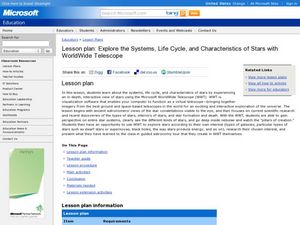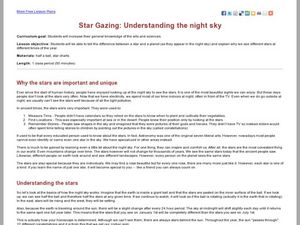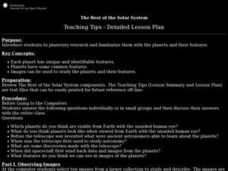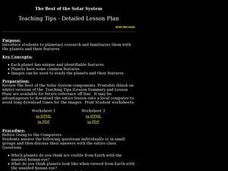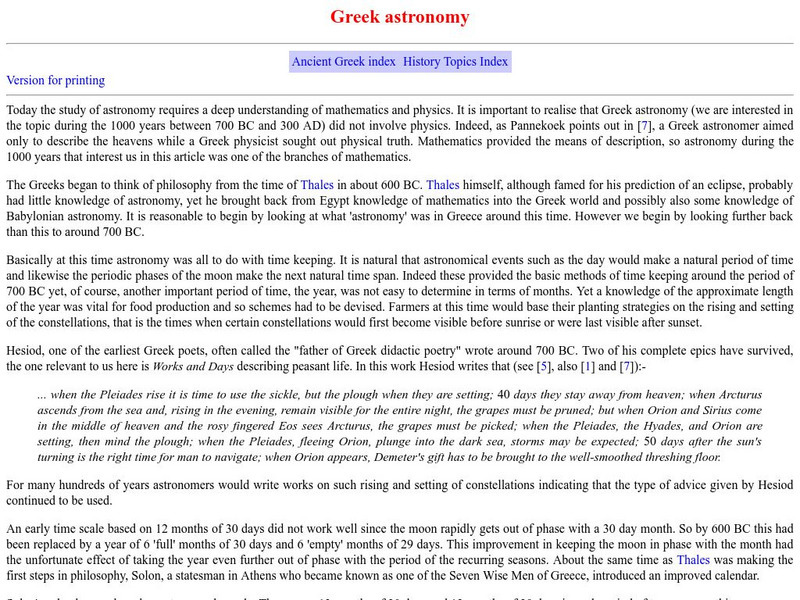Curated OER
Asteroids
Students examine the different types of asteroids and how they enter the atmosphere. In this space lesson students use mashed potatoes to create an asteroid they can eat.
Curated OER
Pilgrims and Puritans
With graphic organizers galore, learners will follow the changes of church and state in early colonial America. They look at the differences between the pilgrims and the puritans in terms of beliefs and life ways. Myths and...
Curated OER
Ptolemy vs. Copernicus
Students list differences in the diagrams of a geocentric universe and a heliocentric universe. They students describe the religious impact of this change on man's conception of the universe and man's place within it. Students describe...
Curated OER
Explore the Characteristics of Stars with Microsoft WorldWide Telescope
Students explore the characteristics of stars. For this space science activity, students use the Microsoft WorldWide Telescope program to identify the properties of stars and identify the stars in the galaxy.
Curated OER
Maya Lesson Plans
Mayan cities may have mysteriously disappeared, but the culture still thrives today. Maya lesson plans bring the culture alive.
Curated OER
Meso-America
Students will identify and locate Central and South America and their countries and features, as well as Meso-American civilizations. Students will compare civilizations and discuss voyages of relevant explorers.
Curated OER
Understanding Newton's Laws
In this physics worksheet, students investigate Newton's Three Laws. In this multiple choice, matching, and short answer worksheet, student answer eleven questions.
Curated OER
Similar Right Triangles-Introductions to Trigonometry
In this geometry worksheet, students examine similar right triangles as the basis for the foundation of trigonometry. Students define the basic trigonometric functions and use a calculator to find the trigonometric value of an angle. The...
Curated OER
Star Gazing: Understanding the night sky
Young scholars observe star charts to understand the difference between a star and a planet. In this star lesson plan, students also explain why we see different stars at different times of the year.
Curated OER
The Best of the Solar System (Grades 4-7)
Learners explore planetary research and become familiar with the planets and their characteristics. They compare and contrasts planets and moons.
Curated OER
The Best of the Solar System (Grades 6-8)
Students are introduced to planetary research and become familiar with the planets and their features. They view images of the planets, and fill in an information chart which is imbedded in this plan.
Curated OER
The Planets Terra Firma
High schoolers explore the theories of the creation of the universe and examine the properties of celestial bodies. They analyze the relationship between the sun, Earth and the other planets.
Curated OER
Planetary Research (Grades 9-12)
Students are introduced to planetary research and familiarize them with the planets and their features. They see that each planet has unique features. Planets have some common features and that images can be used to study the planets and...
Curated OER
How Distant is the Moon?--2
Students examine total eclipses of the Sun and their limited regions of totality. They explain that this limited view occurs because the Moon is close enough to us for different points on Earth to view it differently.
Curated OER
Me Oh Maya
Students compare basketball to Mayan ring-ball. They write a newspaper article that may have been published during Mayan times.
Curated OER
Multiculturalism Through African Folk Tales And Mayan Myths
Students study the myths of various African cultures and of the Mayan people. They identify unique characteristics of African myths and Mayan myths. They define and recognize the style and tone of the Mayan myths and create their own...
Other
Explorable: Ancient Astronomy, Science and the Ancient Greeks
Discusses the influences of other cultures on ancient Greek astronomers, and the advances made by the Greeks. It highlights major astronomers and those who contributed important ideas from the 6th to the 2nd centuries BC, including...
Smithsonian Institution
National Air and Space Museum: Exploring the Planets: Ancient Times & the Greeks
In ancient times only five planets were known: Mercury, Venus, Mars, Jupiter, and Saturn. Learn about Greek astronomer Ptolemy's theory for the solar system that was to survive for fourteen centuries.
Other
China Daily: China Culture: Astronomy and Geography
Access a collection of articles about the scientific contributions made by the ancient Chinese in the areas of astronomy and geography. Includes write-ups of famous astronomers and geographers, astronomical instruments, and more.
Stephen Byrne
History for Kids: Ancient Chinese Science
History for Kids overview on the science and innovations of ancient China. Students learn about the significant impact China made on the world with contributions in the fields of astronomy, chemistry, physics, meteorology and seismology.
Ducksters
Ducksters: Ancient Mesopotamia: Science, Inventions, and Technology
Kids learn about the Science, Inventions, and Technology of Ancient Mesopotamia such as writing, the wheel, astronomy, and government on this site.
University of St. Andrews (UK)
University of St. Andrews: Greek Astronomy
Provides an overview of ancient Greek astronomy and the major figures who played a role in developing ideas about the Universe.
TED Talks
Ted: Ted Ed: Music and Creativity in Ancient Greece
You think you love music? You have nothing on the Ancient Greek obsession. Every aspect of Greek life was punctuated by song: history, poetry, theater, sports and even astronomy. In fact, music was so important to Greek philosopher Plato...
Canadian Museum of History
Canadian Museum of History: Maya Civilization
Lots of information about many facets of the Maya civilization. Covers the history, people, geography, languages, cities, society, cosmology, the calendar, and lots more. Includes a glossary and a timeline.





